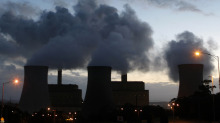Carbon market: there's still time
 A few little things separate a gold medal sprinter from an also-ran. The same applies to the European Union’s carbon emissions trading scheme. When it pioneered the idea of a fully fledged carbon trading market in 2005, the EU envisaged that a price of about €40 per tonne of carbon dioxide equivalent emitted would encourage big polluters, such as power generators, to invest in clean energy. With the current price at under €8, that looks like seriously wishful thinking. Yet the market is not irretrievably broken. With another phase of the trading scheme due to begin next year, there are a few things regulators could usefully do to turn carbon trading into a proper market.
A few little things separate a gold medal sprinter from an also-ran. The same applies to the European Union’s carbon emissions trading scheme. When it pioneered the idea of a fully fledged carbon trading market in 2005, the EU envisaged that a price of about €40 per tonne of carbon dioxide equivalent emitted would encourage big polluters, such as power generators, to invest in clean energy. With the current price at under €8, that looks like seriously wishful thinking. Yet the market is not irretrievably broken. With another phase of the trading scheme due to begin next year, there are a few things regulators could usefully do to turn carbon trading into a proper market.The collapse in the carbon price to one quarter of its 2008 level is due to poor decision-making by the scheme’s operators, and to a handful of scandals. It also faces strong corporate opposition. Chinese and U.S. airlines, for example, are protesting at being forced to buy carbon trading permits.
Useful solutions to some of these problems have been proposed by regulators for the third phase of the scheme. These include centralizing permit allocation and the greater use of auctions rather than allocations. A few further changes could help even more. One is to boost transparency. Currently, the results of emission permit auctions are provided to a select group of banks rather than the broader market. For example, the European Investment Bank announced only last Thursday that it had sold (over the counter) 1.5 million permits on each of three days in January.
Furthermore, about 90 per cent of on-exchange emission trading is conducted on IntercontinentalExchange, which charges €3.50 per trade for the most common emissions contract. That is eight times the cost of trading the contract on UK natural gas. If regulators did more to encourage competition and lower prices, traders - notably hedge funds - would be more interested in giving the carbon trading market the boost it needs to survive.
You can return to the main Market News page, or press the Back button on your browser.

